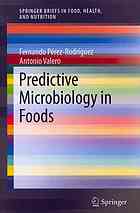

Most ebook files are in PDF format, so you can easily read them using various software such as Foxit Reader or directly on the Google Chrome browser.
Some ebook files are released by publishers in other formats such as .awz, .mobi, .epub, .fb2, etc. You may need to install specific software to read these formats on mobile/PC, such as Calibre.
Please read the tutorial at this link: https://ebookbell.com/faq
We offer FREE conversion to the popular formats you request; however, this may take some time. Therefore, right after payment, please email us, and we will try to provide the service as quickly as possible.
For some exceptional file formats or broken links (if any), please refrain from opening any disputes. Instead, email us first, and we will try to assist within a maximum of 6 hours.
EbookBell Team

5.0
28 reviewsPredictive microbiology is a recent area within food microbiology, which studies the responses of microorganisms in foods to environmental factors (e.g., temperature, pH) through mathematical functions. These functions enable scientists to predict the behavior of pathogens and spoilage microorganisms under different combinations of factors. The main goal of predictive models in food science is to assure both food safety and food quality. Predictive models in foods have developed significantly in the last 20 years due to the emergence of powerful computational resources and sophisticated statistical packages. This book presents the concepts, models, most significant advances, and future trends in predictive microbiology. It will discuss the history and basic concepts of predictive microbiology. The most frequently used models will be explained, and the most significant software and databases (e.g., Combase, Sym’Previus) will be reviewed. Quantitative Risk Assessment, which uses predictive modeling to account for the transmission of foodborne pathogens across the food chain, will also be covered.